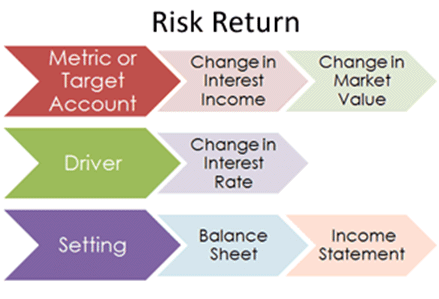Asset Liability Management – Learning Roadmap
| The Asset Liability Management (ALM) process is used to manage the business and financial objectives of an institution by assessing and evaluating assets and liabilities on its portfolio in an integrated manner. ALM is a continuous process involving the formulation, implementation, review and subsequent revision (if needed) of asset and liability management strategies to ensure that they are within the acceptable risk tolerance levels. | ||
| ALM primarily and traditionally addresses interest rate mismatch and liquidity risks through tools such as duration and convexity metrics, and value at risk based concepts such as Earnings at Risk and Market Value of Equity. |  |
What are the prerequisites?
Basic Tools
We begin the Asset Liability Management (ALM) course by first reviewing some preliminary topics that will be applied within the course. These include:
- Calculating Value at Risk (VaR)
- Duration & Convexity Calculation Example
- Building Maturity & Liquidity profiles for Deposits and Advances book for ALCO (ALM), ICAAP & IAS 30 reporting
ALM and Regulatory Environment
In addition to these prerequisite courses we also review how the Asset Liability Management (ALM) process is addressed in the current regulatory environment for capital adequacy requirements as outlined in Basel II and the changes that Basel III will bring to the existing capital framework in particular with regard to liquidity risk regulations:
- Internal Capital Adequacy Assessment Process (ICAAP) – Overview and Core Concepts
- Basel III: Basel II Framework Revisions
- Basel III – Liquidity Framework – Reforms to Global Liquidity Risk Regulations
What topics are covered?
Once a review of the prerequisite topics has been covered you can now move on to the main Asset Liability Management Course. This course covers:
- Asset Liability Management (ALM) measurement tools such as:
- Duration
- Rate Sensitive Gaps
- Earnings at Risk (EAR)
- Cost-to-Close
- Interest Rate Gap
- Cost-to-Close
- Liquidity Gap
- Market Value of Equity (MVE) Analysis
- Price Sensitive Gap
- Liquidity Gap
- Net Interest Income (NII) at Risk and
- Duration Gap Analysis

- Applications of ALM such as:
- cash flow matching
- portfolio dedication
- immunization, and
- How convexity is used in the ALM process
- Discussion of liquidity risk, liquidity ratios and analysis, liquidity limits and the liquidity contingency plan
We then review some simple ALM stress tests for liquidity and interest rate risks:
What are the additional topics I can read up on?
For a more detailed discussion on the liquidity risk management process you may also like to review the following posts:
- Liquidity Risk Management – A framework for estimating liquidity risk capital for a bank
- Basel III enhancement – Linking liquidity crisis with Liquidity Coverage Ratio and Stable Funding Ratios
- Liquidity Risk Management Case Studies
- Asset Liability Management for board members.
Other topics related to the Asset Liability Management (ALM) process include:
- Interest Rate Simulation Crash Course
- Setting Counterparty Limits, Market Risk Limits & Liquidity and Interest Rate Limits

Related Online Courses
Related PDF files:
- ALM – Crash Course
- ICAAP – Overview & Core Concepts
- Basel III – Liquidity Framework
- Calculating VaR – includes case study
- Interest Rate Simulation Crash Course
- How to construct a Black Derman Toy Model in EXCEL
- How to utilize results of a Black Derman Toy Model
- Setting Counterparty Limits
- ICAAP Sample Report Template & Executive Summary
- Building Maturity and Liquidity Profiles for Advances and Deposits
Related EXCEL files:
- ALM Crash Course – EXCEL Example (Examples include: Cost to close liquidity gaps, Cost to close interest rate risk, Earnings at risk, Market value of equity)
- Duration Convexity Example
- Calculating VaR – EXCEL Example
- Calibration of the CIR Model Example
- Black Derman Toy Model Construction – EXCEL Example
- How to utilize the results of a Black Derman Toy Model – EXCEL Example
- Heath Jarrow Merton – HJM 3 – Factor Interest Rate Model
- Principal Component Analysis – PCA – US Treasury Yield Rates
